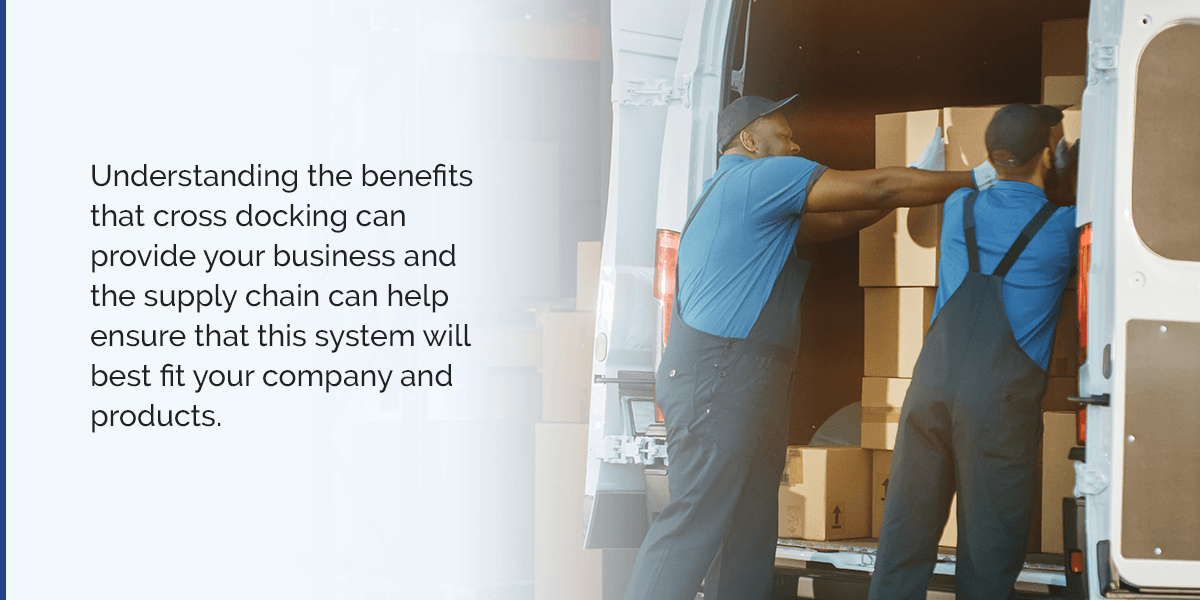Cross Docking Can Help Streamline Your Replenishment Supply Chain

March 9, 2022
Warehouses are always searching for ways to increase the efficiency of their supply chains. Cross docking offers one such way to reduce lead times, while cutting costs across both transportation and warehousing. Behemoths like Amazon and Walmart are already using cross docking to ensure short delivery periods, but it can also benefit manufacturers and distributors of many sizes.
Unsure if cross docking is the right replenishment solution for your business? Understanding how you can use cross docking at your warehouses can help you determine if it’s the right choice to implement in your supply chain.
What Is Cross Docking?
Before you can get started with cross docking, you need to know how it works. Cross docking is the process of unloading and sorting products as they arrive at a warehouse or a distribution center (DC), and immediately reloading them into different vehicles for shipment. This method uses the warehouse as a transfer point, instead of a storage facility. As a result, cross docking allows warehouses to ship products more efficiently since they have everything they need already at the dock, where they can organize and prepare it for shipment.
To implement cross docking, you’ll need to “split” your warehouse into two terminals — incoming and outgoing. Each terminal will include multiple docks where trucks can park to unload or receive products. At the incoming docks, warehouse employees will unload all deliveries and bring them into the terminal, where they will then sort them by their next destination and screen their quality.
When employees finish unloading, they send products through an internal transportation route to the outgoing docks. This can include forklifts, pallet trucks or even conveyor belts, allowing for efficient transport across the terminal. At the outgoing terminal, employees can then organize products by their final destination and load items into trucks for shipping.
One challenge to cross docking is scheduling. You’ll need to ensure that incoming trucks and outgoing trucks are well coordinated. To succeed, you should schedule enough time between one truck arriving and the other departing to unload, examine the items, and load them into the next truck. But you’ll also need to be wary of having too much time between incoming and outgoing trucks, as this could lead to an overflow of products in your warehouse terminals.
The Benefits of Cross Docking
Despite the complexity of implementing cross docking, it can benefit many supply chain components, from the retailer to the customer. Some advantages of using a cross docking system include:
- Storage savings at warehouses: An implemented cross docking process can eliminate the need to store items. When you use a cross docking terminal, employees can move items to their outgoing truck directly after they arrive. This system can allow warehouses to save valuable shelf space for items that need long-term storage and keep products moving along the supply chain.
- Reduced costs for retailers: Cross docking helps increase efficiency at several crucial points along the supply chain, allowing retailers to decrease their costs. Because cross docking reduces the amount of handling products need, retailers often pay less handling fees. With more efficient transportation that requires less room for products, retailers can also save money on transportation costs. Lastly, cross docking eliminates the need for storing goods, which they can also save money on.
- Better for temperature-controlled products: Many warehouses have difficulty maintaining conditions for items with specific temperature or perishability requirements, like food or pharmaceuticals. Because cross docking minimizes time spent at warehouses, you can better ensure the quality of these products right up to the last mile.
- Increased organization: With cross docking, employees sort packages by location and client as they come into warehouses and load them to depart, ensuring better warehouse organization. Employees will better understand where products are within the warehouse and where they need to be going, leading to more efficient loading and unloading.
- Optimized transportation processes: Cross docking can provide several transportation benefits. Warehouses can make transportation more efficient by grouping products shipping to similar locations together in one vehicle, so they can better use available space and quickly get items to their destination.
- Improved quality and damage inspections: Because cross docking requires employees to sort and organize products as they unload them, they can also inspect each product closely for any damages from transportation. Flagging poor-quality products at this stage can ensure that customers only receive the best version of each product, helping to promote customer satisfaction.
- Enhanced customer satisfaction: Cross docking allows customers to receive items more quickly by moving them directly to outgoing trucks and pairing them with items moving in a similar direction. Further, customers will appreciate the care given to their products with increased quality control. With better customer care, businesses can experience increased customer retention rates, better reviews online, and even greater sales.
Why Should Your Business Consider Cross Docking?
Supply chains were busy, and warehouses were overloaded already in 2019; when the COVID-19 pandemic hit, capacity issues only grew. When the pandemic first began, many stores, factories and ports shut down to protect employees and the public, causing warehouses to save supplies and products to maintain standard product levels.
When these locations reopened again in 2021, businesses started ordering and making more products to account for lost time. The emergency stores in warehouses combined with the sudden increase of new products has left many warehouses at 99% capacity, making it challenging for them to continue to store items.
In addition to problems at the retailer level, customer buying habits are different than before the pandemic, changing how warehouses function in the supply chain. Since customers couldn’t go to stores to buy items, they flocked to online shopping, where they could receive items in a matter of days. This has increased the importance and strain on warehouses and storage methods.
Many companies have responded to this issue by building new warehouses, which will help reduce the pressure. However creating a quality warehouse is a long and costly process. Instead, warehouses can consider cross docking as many items as possible to save space and increase warehouse efficiency.
In some cases, even if a new warehouse is an option, cross docking can be a faster way to move product, while cutting costs across the supply chain. If your business faces ongoing capacity issues or wants to minimize goods placed in storage moving forward, cross docking might be the perfect solution.
Enhance Cross Docking Efficiency with TrueCommerce
Cross docking supply chains can help increase efficiency across several steps, especially in the warehouse. With cross docking, you can see increased organization, lower costs, and higher customer satisfaction. Additionally, by using cross docking, you can help insulate your warehouses from future supply chain disruptions like the ones seen during the pandemic!
You can further improve the cross docking process by implementing automation to handle certain actions and stages. By receiving proper store-level data, TrueCommerce’s Vendor Managed Inventory (VMI) software can help organize items for each truckload, marking which products need to go on which trucks for minimized confusion and mistakes. It can further organize the process by grouping products together, so you can ensure increased efficiency for limited transportation space. A VMI system will take into account all the products in a shipment, and their various destinations to better match products with the right outgoing trucks. This, in turn, leads to greater dock efficiency, enabling you to move inventory faster.
When you choose our VMI platform, TrueCommerce handles implementation and testing with your suppliers, so your IT team can focus their efforts on more critical tasks. As part of our managed service approach, we also offer training for your analysts and inventory planners. This empowers your team to leverage VMI to make day-to-day procurement decisions and adjustments. The solution is also highly flexible, so you can configure it to meet the needs of your warehouses and customers.
Request a free VMI demo today and discover how you can leverage cross docking to increase efficiency while cutting costs in your warehouses.
About the Author: Scott Kleinert is a global sales executive with more than 25 years of experience in supply chain strategy development. He is currently responsible for TrueCommerce’s collaborative management service offering with specific expertise in the consumer goods and retail industries. Scott leads the team that initiates and develops the TrueCommerce vendor managed relationships as well as cementing the value associated with these collaborative initiatives. Scott lives in South Carolina, taking advantage of all that coastal living offers.
Share this post:
Stay ahead of the competition
Get expert supply chain insights delivered directly to your inbox weekly.

